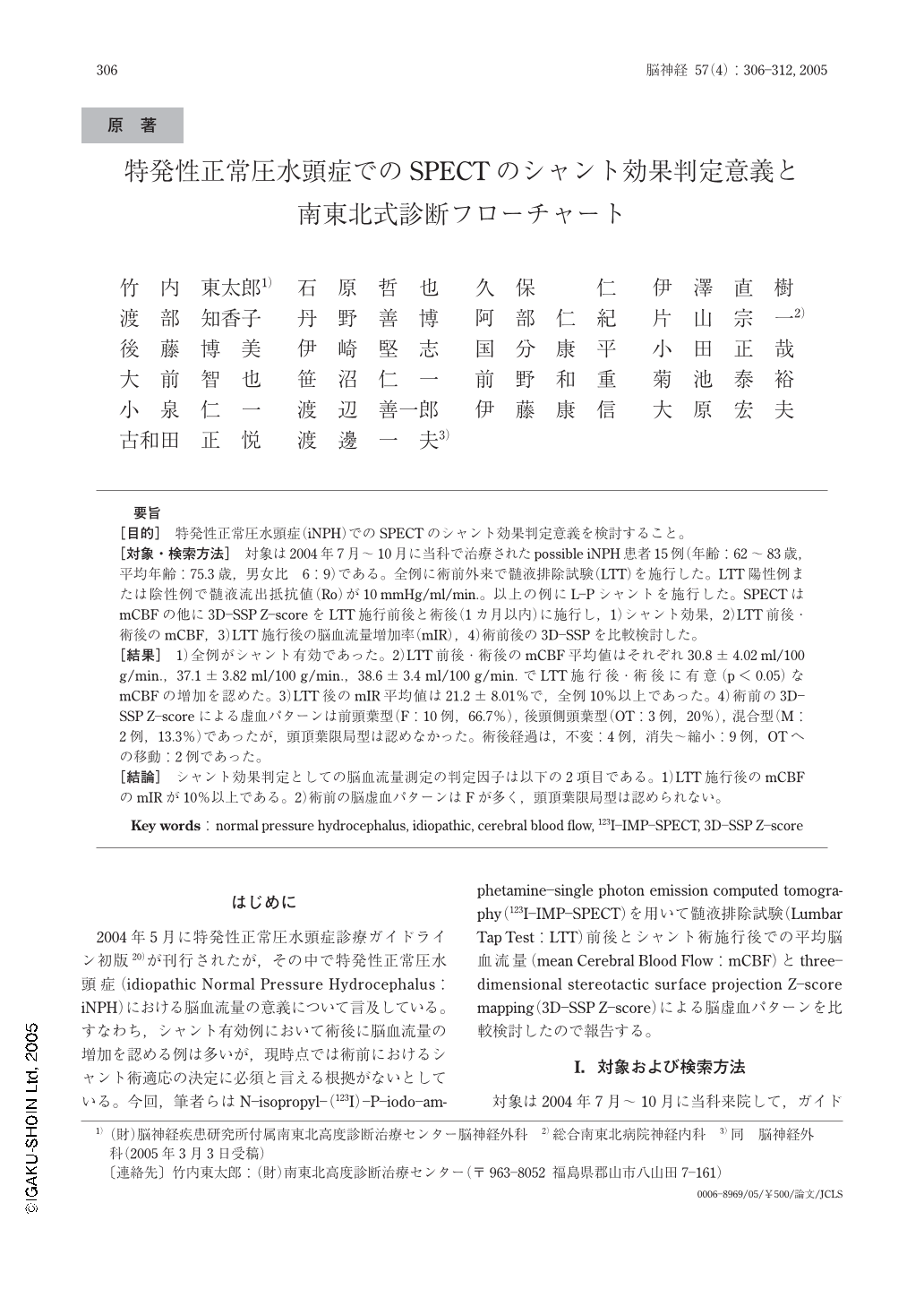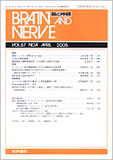Japanese
English
- 有料閲覧
- Abstract 文献概要
- 1ページ目 Look Inside
要旨
[目的] 特発性正常圧水頭症(iNPH)でのSPECTのシャント効果判定意義を検討すること。
[対象・検索方法] 対象は2004年7月~10月に当科で治療されたpossible iNPH患者15例(年齢:62~83歳,平均年齢:75.3歳,男女比 6:9)である。全例に術前外来で髄液排除試験(LTT)を施行した。LTT陽性例または陰性例で髄液流出抵抗値(Ro)が10mmHg/ml/min.。以上の例にL-Pシャントを施行した。SPECTはmCBFの他に3D-SSP Z-scoreをLTT施行前後と術後(1カ月以内)に施行し,1)シャント効果,2)LTT前後・術後のmCBF,3)LTT施行後の脳血流量増加率(mIR),4)術前後の3D-SSPを比較検討した。
[結果] 1)全例がシャント有効であった。2)LTT前後・術後のmCBF平均値はそれぞれ30.8±4.02 ml/100g/min.,37.1±3.82 ml/100g/min.,38.6±3.4 ml/100g/min. でLTT施行後・術後に有意(p<0.05)なmCBFの増加を認めた。3)LTT後のmIR平均値は21.2±8.01%で,全例10%以上であった。4)術前の3D-SSP Z-scoreによる虚血パターンは前頭葉型(F:10例,66.7%),後頭側頭葉型(OT:3例,20%),混合型(M:2例,13.3%)であったが,頭頂葉限局型は認めなかった。術後経過は,不変:4例,消失~縮小:9例,OTへの移動:2例であった。
[結論] シャント効果判定としての脳血流量測定の判定因子は以下の2項目である。1)LTT施行後のmCBFのmIRが10%以上である。2)術前の脳虚血パターンはFが多く,頭頂葉限局型は認められない。
Purpose : The purpose of this study was to investigate the significance of the shunt-effect evaluation of SPECT in idiopathic normal pressure hydrocephalus(iNPH).
Subjects and methods : The subjects were 15 patients with possible iNPH, aged 62-83 (mean 75.3, the ratio of males to females to 6 : 9), who were treated at our department during the period from June to September, 2004. All patients received the lumbar tap test (LTT) at the outpatient section before surgery. An L-P shunt was conducted on patients whose the LTT positive or negative with cerebrospinal fluid outflow resistance value (Ro) was 10mmHg/ml/min. or higher patients. As for SPECT, a 3D-SSP Z-score, as well as an mCBF, was conducted before and after the LTT and within one month after surgery. Comparisons were made for (1) the shunt effect, (2) mCBF before and after the LTT and after surgery, (3) mean cerebral blood flow increase rate (mIR) after the LTT, and (4) 3D-SSP before and after surgery.
Results : (1) The shunt was effective for all the patients. (2) The mCBF levels was 30.8±4.02 ml/100g/min. before the LTT, 37.1±100g/min. after the LTT, and 38.6±3.4 ml/100g/min. after surgery. A significant increase in mCBF was observed both after the LTT and after surgery(p<0.05). (3) The mean mIR after the LTT was 21.2±8.01%, with all the patients showing 10% or higher. (4) The ischemic patterns in the SD-SSP Z-score before surgery were the frontal type (F : 10 cases, 66.7%), the occipitotemporal type (OT : 3 cases, 20%), and the mixed type (M : 2 cases, 13.3%), but not the parietal localized type. The post-operative course showed no-change in 4 cases, disappearance~reduction in 9 cases, and shift to OT in 2 cases.
Conclusion : The evaluation factors in the measurement of the cerebral blood flow for evaluation of the shunt effect were the following two items. (1) The mIR of mCBF after the LTT was 10% or higher. (2) As for the preoperative cerebral ischemic patterns, there were many F cases and no parietial localized types found.
(Received : March 3, 2005)

Copyright © 2005, Igaku-Shoin Ltd. All rights reserved.


